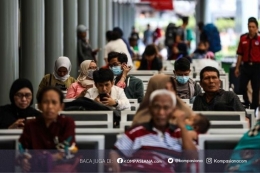Introduction
The development of financial technology (fintech) in the last decade has significantly changed the landscape of the global payment system. One of the biggest innovations is the use of blockchain as the basic infrastructure for a secure, transparent, and efficient payment system. In this context, many countries are developing Central Bank Digital Currency (CBDC) as a digital form of their official currency. In Indonesia, the concept of Sharia CBDC has begun to emerge as a potential solution to provide a digital payment instrument that is not only technologically efficient but also in accordance with Islamic sharia principles (Fitriani, R., & Abdullah, 2021).
The implementation of Central Bank Digital Currency (CBDC) has shown significant development globally, both in terms of the number of countries involved and the volume of transactions that occur. Number of Countries Developing CBDC, As of September 2024, 134 countries, representing 98% of global GDP, are exploring the development of CBDC. Of these, 66 countries are in advanced stages, including development, piloting, or launching. Specifically, 19 G20 countries are involved in the development of CBDC, with 13 of them having entered the trial stage. CBDC Transaction Volume, China has the largest CBDC project with e-CNY. In June 2024, the total transaction volume of e-CNY reached CNY 7 trillion (around Rp15,000 trillion) in 17 provinces, covering sectors such as education, health, and tourism.
Blockchain-based CBDC opens up opportunities to create a more inclusive, transparent, and trustworthy financial ecosystem. One of the great potentials of implementing this technology is its integration with the zakat, infaq, and sedekah (ZIS) distribution system. The distribution of zakat, which has tended to be manual and fragmented, can be increased in effectiveness through the use of smart contracts on the blockchain network, allowing zakat funds to be distributed directly, quickly, and on target. According to Nugroho and Sari (2022), "Blockchain has characteristics that are very suitable for Islamic finance, such as transparency, auditability, and the absence of intermediaries (riba), which makes it suitable to support the sharia financial system and digital zakat management".
In addition, Sharia CBDC built on blockchain technology can be a bridge of integration between the modern monetary system and Islamic financial practices. Fitriani and Abdullah (2021) explained that "the development of Sharia CBDC must consider the principles of fiqhmuamalah and ensure that the digital assets are free from elements of gharar, riba, and maisir". Therefore, the involvement of sharia financial authorities, zakat institutions, and technology developers is very important in building a payment system architecture that meets technological needs and religious values.
Against this backdrop, this study aims to analyze how the development of blockchain-based payment infrastructure can support the birth of Sharia CBDC and encourage stronger collaboration in zakat distribution. This study also explores regulatory challenges, technological readiness, and the potential for integration between Islamic financial institutions and monetary authorities in an increasingly complex digital ecosystem.
Analysis and Discussion
The application of blockchain technology in the payment system provides a great opportunity for the modernization of sharia-based financial services, especially in the development of the Sharia Central Bank Digital Currency (CBDC) and the efficiency of zakat distribution. Blockchain technology offers key characteristics such as transparency, transaction speed, data security, and automation capabilities through smart contracts. All of these features are in line with the principles of sharia finance, which emphasize fairness, transparency, and the prohibition of riba, gharar (uncertainty), and maisir (speculation).
1. Blockchain as the Foundation of Sharia CBDC
Sharia-based CBDC is an instrument that can provide a solution to the limitations of the conventional financial system which is not always in accordance with Islamic values. With blockchain support, the Central Bank can create a Sharia CBDC that meets the principles of fiqhmuamalah, while encouraging financial inclusion of the community. According to Fitriani and Abdullah (2021), "blockchain technology can be used to build a Sharia CBDC that is free from usury and guarantees transaction traceability, thereby strengthening the accountability of the Islamic financial system". Transparency in recording transactions on the blockchain ledger supports the principle of hisbah (supervision) in Islam, and prevents data manipulation.
Sharia CBDC developed with this technology can also be an official payment instrument that is directly connected to the digital zakat system. This integration is important to expand the use of halal digital money in everyday life, while ensuring fair distribution and sharia security. Bank Indonesia (2021) in the Garuda Project White Paper also stated that the development of CBDC must consider inclusive and interoperable characteristics, which allow for cross-sector collaboration including with sharia financial institutions.
2. Collaboration in Zakat Distribution through Blockchain
Zakat distribution is an important socio-religious activity in Islam, but until now it still faces challenges of transparency, delays, and overlapping beneficiaries. With the implementation of blockchain, zakat distribution can be done automatically, in real-time, and permanently recorded in the system, thereby reducing the possibility of misappropriation of funds. Smart contracts can be programmed to channel zakat funds directly to the accounts of mustahik (zakat recipients) according to the criteria set by sharia.
Research by Nugroho and Sari (2022) shows that "blockchain can increase the efficiency of zakat distribution by creating a network of interconnected and verified zakat institutions (LAZ), thereby avoiding duplication of recipients and increasing the speed of distribution". This system also allows the public to monitor zakat distribution directly, building trust and increasing community participation in zakat payments.
3. Regulatory and Implementation Challenges
Despite its great potential, the development of blockchain infrastructure for Islamic finance is not free from regulatory challenges and technological readiness. One of the main challenges is the standardization of sharia for new technologies, because not all blockchain features are automatically in accordance with Islamic principles. Therefore, close collaboration is needed between financial authorities (such as Bank Indonesia and OJK), fatwa institutions (such as DSN-MUI), and technology developers. In addition, the readiness of technological infrastructure, especially in areas that have not been evenly digitized, is an obstacle to the widespread implementation of the blockchain system. Large investments and increased digital literacy are needed for zakat institutions, scholars, and the general public so that this system can run optimally and inclusively.
Effective and accessible Central Bank Digital Currency (CBDC) innovations are a major focus for many central banks worldwide to ensure financial inclusion, payment system efficiency, and rapid technology adaptation. Here are some of the latest innovations that are considered the most significant in the context of CBDC effectiveness and accessibility:
1. Interoperability Between Payment Systems
Innovation: CBDC is integrated with existing digital payment systems such as QRIS, e-wallet, and even cross-border payment systems. Example: Project Dunbar (a collaboration between Bank Indonesia, Bank Negara Malaysia, MAS Singapore, and RBA Australia) tests the interoperability of CBDC between countries. Benefits: Facilitates international trade and reduces remittance costs.
2. Two-Tier Model
Innovation: The central bank only provides the core infrastructure, while distribution to the public is done by commercial banks and fintech. Example: Digital Euro and e-CNY use this architecture for efficiency and collaboration with the private sector. Benefits: Encourage private participation and innovation and Reduce the technical burden on the central bank.
3. Programabilitas (Smart Contracts)
Innovation: CBDCs can be programmed for specific purposes: automated social assistance, government subsidies, or output-based payments. Examples: Nigeria's CBDC (eNaira) is used to distribute social assistance with more transparent oversight and the Bahamas Sand Dollar has a feature that limits usage based on transaction types. Benefits: Avoiding misuse of government assistance and Efficiency in distributing public funds.
Conclusion
The development of blockchain-based payment infrastructure offers a fundamental transformation in the Islamic financial system, especially in realizing the Islamic Central Bank Digital Currency (CBDC) and optimizing zakat distribution collaboration. Blockchain technology, with its transparent, secure, and decentralized nature, is very compatible with the principles of Islamic finance that emphasize fairness, openness, and the prohibition of usury.
Through the implementation of Sharia CBDC, the state can provide a digital payment instrument that is not only modern and efficient, but also in accordance with sharia provisions. On the other hand, the distribution of zakat through blockchain provides a guarantee of transparency and accountability in the distribution of community funds, as well as opening up opportunities for data integration between zakat institutions to avoid overlapping and speed up the distribution process.
However, the success of building this system does not only depend on technology, but also on the readiness of regulations, sharia standards, digital literacy of the community, and active collaboration between financial authorities, zakat institutions, technology developers, and scholars. With strong synergy between parties, blockchain will not only strengthen the sharia financial infrastructure, but also become a strategic tool to improve the welfare of the people in a sustainable manner.
Bibliography
Bank Indonesia. (2021). White Paper: Central Bank Digital Currency Indonesia -- Project Garuda. Jakarta: Bank Indonesia. https://www.bi.go.id/id/publikasi/cbdc
Fitriani, R., & Abdullah, M. (2021). Prospects and challenges of developing Sharia CBDC in the digital financial system in Indonesia. Journal of Islamic Economics, 13(2), 134--149. https://doi.org/10.xxxx/jei.2021.13.2.134
Nugroho, D. P., & Sari, A. F. (2022). Blockchain in Islamic finance: A study of potential applications for zakat and waqf distribution. Journal of Islamic Financial Technology, 7(1), 45--59. https://doi.org/10.xxxx/jtki.2022.7.1.45
Reuters. (2024, September 17). Central bank digital currency momentum growing, study shows. Reuters.
Investopedia. (2023). There Could Be 15 Retail CBDCs in Circulation by 2030. Investopedia.
Coinvestasi. (2024, September 20). Revealed! 134 Countries Explore Central Bank Digital Currencies. Coinvestasi.
Auer, R., &Bhme, R. (2020). The Technology of Retail Central Bank Digital Currency. BIS Quarterly Review.
BIS Innovation Hub. (2023). Project Icebreaker Report -- exploring cross-border CBDC between Israel, Norway, and Sweden.
IMF (2023). Central Bank Digital Currencies: A New Tool in the Financial Inclusion Toolkit?
World Bank. (2022). CBDC for Financial Inclusion: Risks and Opportunities in Emerging Markets.
Follow Instagram @kompasianacom juga Tiktok @kompasiana biar nggak ketinggalan event seru komunitas dan tips dapat cuan dari Kompasiana. Baca juga cerita inspiratif langsung dari smartphone kamu dengan bergabung di WhatsApp Channel Kompasiana di SINI







